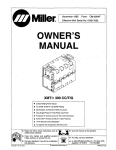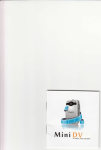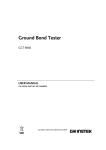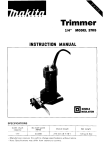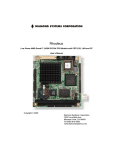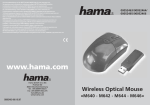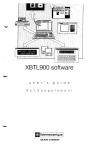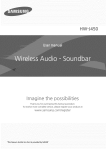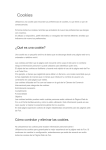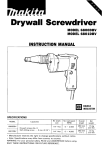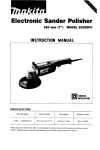Download Makita SR1800 User's Manual
Transcript
l S S m m ( 7 X ' ' ) MODEL S R l S O O INSTRUCTION MANUAL 1 Circular Saw & Standard Equipment Ii 1 j I ,I ! i j i ~ I I I I i 1' -2' Tool body Guide rule DOUBLE INSULATION P Socket wrench (9) Specifications Blade diameter Max. cutting depth 45O 1 goo Continuous rating ( I nput) No load speed Overall length Net weight Power supply cord I 185" 45" 65" 290" 4.2kg 2.5 m BEFORE CONNECTING YOUR TOOL TO A POWER SOURCE Be sure you have read all GENERAL POWER TOOL SAFETY RULES GENERAL SAFETY PRECAUTIONS 1. KEEP WORK AREA CLEAN. Cluttered areas and benches invite accidents. 2. AVOID DANGEROUS ENVIRONMENT. Don't use power tools in damp or wet locations. Keep work area well lit. Do not expose power tool in rain. 3. KEEP CHILDREN AWAY. All visitors should be kept safe distance from work area. 4. STORE IDLE TOOLS. When not in use, tools should be stored in dry, high or locked-up place-out of the reach of children. 5. DON'T FORCE TOOL. * it was designed. It will do the job better and safer a t the rate for which 6. USE RIGHT TOOL. Don't force small tool or attachment to do the job of a heavyduty tool. 7. WEAR PROPER APPAREL. No loose clothing or jewelry to get caught in moving parts. Rubber gloves and footwear are recommended when working outdoors. 8. USE SAFETY GLASSES. Use safety glasses with most tools. Also face or dust mask if cutting operation is dusty. 9. DON'T ABUSE CORD. Never carry tool by cord or yank it to disconnect from receptacle. Keep cord from heat, oil, and sharp edges. 10. SECURE WORK. Use clamps or vise to hold work. It's safer than using your hand and it frees both hands to operate tool. 11. DON'T OVERREACH. Keep proper footing and balance a t all times. 12. MAINTAIN TOOLS WITH CARE. Keep tools sharp and clean for best and safest performance. Follow instructions for lubricating and changing accessories. 13. DISCONNECT TOOLS. When not in use; before servicing; when changing bladeor adjusting guides. 14. REMOVE ADJUSTING KEYS AND WRENCHES. Form habit of checking to see that keys and adjusting wrenches are removed from tool before turning it on. 15. AVOID ACCIDENTAL STARTING. Don't carry plugged-in tool with finger on switch. Be sure switch is OFF when plugging in. 16. OUTDOOR USE EXTENSION CORDS. When tool is used outdoors, use only extension cords suitable for use outdoors and so marked. 17. Keep Guards i n Place and in Working Order. 18. Keep Blades Sharp. 19. Keep Hands Away from Cutting Area. 20. REPLACEMENT PARTS. When servicing use only identical replacement parts. PRELIMINARY INSTRUCTIONS Your electric tool is precision built and manufactured t o satisfy the highest standards. For maximum performance, long tool life, and your safety, follow these instructions carefully. VOLTAGE WARNING: Before connecting the tool to a power source (receptacle, outlet, etc.) be sure the voltage supplied is the same as that specified on the nameplate of the tool. A power source with voltage greater than that specified for the tool can result i n SERIOUS INJURY t o the user as well as damage to the tool. I f in doubt, DO NOT PLUG I N THE TOOL. Using a power source with voltage less than the nameplate rating is harmful t o the motor. - HOW TO USE 1i . Planiqg depth (cutting volume) may be adjusted as desired by simply turning the knob (front grip) on the front of the power planer. 2. To start the tool, simply pull the trigger. Release the trigqer _ _ to stop. Models with a lock button G S the handle may be run continuously without keeping your finger on the trigger. To lock the trlgqer in the ON position, first pull the trigger and then depress the lock button on the handle with your thumb. To stop the tool from the lock position, just pull the ?rigger again and release it. Lock button Trigger switch I r 3. After you switch on the tool by pulling the trigger, h a i t until the planer is running a t top speed before bringing it into contact with the wood. Planing will be easier if you incline the workpiece in stationary fashion, so that you can plane somewhat downhill. 4. Starting & Finishing Planing Work First, rest the tool front shoe flat upon the work surface. Switch on, then move the planer gently forward. Apply pressure to tool as indicated (photo), a t start and end of planing. Fig. 2 5. For Fine Finishes The speed and volume of planing determine the kind of finish. The power planer keeps cutting a t a speed that will not result in jamming by chips. For rough cutting, the volume is upped, while for a good finish you should cut less and advance the tool more slowly. 3 REPLACING INSTALLING PLANER BLADES After unplugging the tool, you may remove the planer blades on the tool drum by unscrewing the three installation bolts with the socket wrench provided. The clamp plate comes off together with the blades. See Photo. 4-c Fig. 3 When you install new or sharpened blades, H e x . flange hd. bo first clean out a l l chips or foreign matter adhering to the drum or blades. Use blades of the same dimensions and weight, or Drum drum oscillation/vibralion will result, causPlaner blade ing poor planing action and, eventually, Blade c l a m p pla tool breakdown. Fig. 4 Screw the blade onto the adjust plate, slip it intd the groove on the drum, then fit the blade clamp on over it. Fasten with hex flange hd. bolt. See diagram a t above. When properly installed, the side of the blade should be flush with the outside edge of the front and back shoes. For rabbeting, the edge of the blade should be made t o protrude outside slightly (0.3 mm - 0.6 mm : 1/64” - 1/32”). Otherwise, nicks and generally poor rabbeting results. Fig. 5 Using blade gauge for even blade setting Although the blade protrusion for desired cutting depth IS easily obtainea by turning the front knob, the setting of the blade itself in relation to the work may require adjustment This is done conveniently with the blade gauge provided. First, remove the blade from the tool by unscrewing the hex bolts. Now set the blade on the gauge base so that the cutting edge of the blade is perfectly flush with the inside surface of the gauge plate. Loosen the screws on the adjust plate (if they are not already so), then simply press in the heel of the adjust plate flush with the back side of the gauge base and tighten the two Phillips screws on top. This insures that your blade tip will be set properly when remounted in the tool so as to provide perfectly even planing. ( 1 ) Set blade tip flush with inside surface of gauge plate (2) Press in heel of adjust p l a t e flush with back sidp of gauge base (3)Tighten two Phillips screws to hold blade in place Fig. 6 4 FOR THE CORRECT PLANER BLADE SETTING Your planing surface will end up unsmooth and not level, unless the blade is set properly and securely. The blade must be mounted so that the cutting edge is absolutely level, that is, parallel t o the surface of the rear base. Below are some examples of proper and improper settings. ( A ) Front base (Movable shoe) Although this side view cannot show it, the edges of the blades run perfectly parallel to the rear base surface. Cause One or both blades fails to have edge parallel to rear base line. Nicks i n surface Cause. One or both blade edges fails t o protrude enough in relation t o rear base line. Cause One or both blade edges protrudes too far i n relation to rear base line Gouging SHARPENING PLANER BLADES Although a power planer considerably outperforms an ordinary hand plane, by the same token the blades become dull faster. Always keep your blades sharp for the best performance possible. Use the sharpening holder (photo) t o remove nicks and produce a fine edge. I Sharpening holder I Fig. 7 First, loosen the 2 wing nuts on the holder and insert blades A and B as in figure a t ight, so that they contact side C and D. Then tighten wing nuts. Immerse dressing stone in water for 2 or 3 minutes before sharpening. Grip the holder so that blades both contact the dressing stone for simultaneous sharpening a t the same angle. Stock removal is possible up to 7.5 mm (5/16”).Blades may be used down t o 24.5mm ( I ” ) . Fig. 9 5 USE OF NOZZLE ASSEMBLY Use of the special nozzle assembly (accessory attachment) will prevent chip scatter, making for a clean work area. \ Nozzle assembly Fig. 1( ATTACHING NOZZLE ASSEMBLY The nozzle assembly may be attached after the chip cover on the tool body i s removed. When slipping on the assembly, f i t the pin on it into the rear cover hole. Use the chip cover screws to fasten it in piace. Fig. 11 MAINTENANCE Caibon brushes Replace carbon brushes when they wear down to about 5 mm (YIS") or sparking will occur. Both brushes should be changed a t the same time. ACCESSORIES CAUTION: The use of any other accessories not specified in this manual might be hazardous. 0 Replacement blades Width! 8 2 mm !3-1/4") Part No. 731001-4 0 Planer blades (Material: _ . - Tunasten-carbide) Width. 8 2 mm-(3-1/4") 0 Blade gauge assembly Part No. 123062-2 0 Sharpening holder assembly Part No. 123004-6 0 Planer stand Part No. 122125-1 'i 0 Nozzle assembly Part No. 122194-2 0 0 Guide rule Part No. 164371-0 Dressing stone Part No. 741802-2 Socket wrench 0 Part No. 782209-3 Screwdriver Part No. 783002-8 ---. ! : em-F #e*.,- 8 0 --. Hex flange hd. bolt Part No. 2 5 1 6 0 9 - 3 4 4 6 185mm(7Y4")ClRCULAR S A W Model SR 1800 MODEL S R l 8 W 1 7 ':iM ,":, DESCRIPTION Ab: 'L,'df DESCRIPTION MACHZE 01 1 Switch 1 Single Pole IWithout Lock Button1 SGE115CDY lFor U S A 1 Single Pole IWifh Squared Waher E Without L w k Buttonl GPAH 4 IFor Canadd 42 1 43 1 C S N Bolt M 6 x x ) F Washer 6 1 44 Lever Plate 45 1 Lock Plate 4b 2 C S N Bolt M6x20 47 I Plate 48 1 P H Screw M4r6 IWith Washer] 1 F Washer 6 49 1 50 1 ti Nux M 6 51 t C h Screw M5x20 52 1 i(.ibber S'eevr 5 ' 7 6 %rev. hlSXB 4aSE x S ; f M B - Y IA?>emblebItems 5? & 54, Bore 4CCESSOH IES 4 M 1 40; 1 402 1 ' Chiset Tooth Combinrtion Saw Blrde 1 8 5 , Socket Wrench 9 I I Guide Pclr 7hCLJrCib!€&utmc W 4 " b . u . Anjo. Aichi, h p 8 n PRINTED IN JAPAN 1981-1-N I








